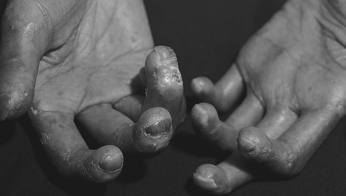77. Scleroderma
Definition
“Scleroderma” literally means “hard or thickened skin.” The disease is a multisystem disorder characterized by inflammation, tissue fibrosis, and microvascular occlusion as the result of excessive production and deposition of collagen types I and III. Characteristics of scleroderma are most obvious in the skin but also appear in the pulmonary, cardiovascular, renal, gastrointestinal, and genitourinary systems.
Incidence
Scleroderma is found worldwide. Frequency is estimated at 19:1,000,000. Women have a 3- to 8-fold greater risk for developing the disease, with the peak onset between 30 and 50 years of age.
Etiology
The exact cause of scleroderma remains unknown. There are proposed pathologic mechanisms, such as endothelial cell injury, activation of fibroblasts, cytomegalovirus (human herpesvirus 5), and immune system derangement. Proposed environmental causative factors for scleroderma include exposure to silica or solvents such as trichloroethylene, epoxy resins, benzene, or carbon tetrachloride. To date, none of these proposed mechanisms have been substantiated.
Signs and Symptoms
• Arthralgia
• Aspiration pneumonia
• Bloating
• Chest pain
• Chronic renal insufficiency
• Constipation alternating with diarrhea
• Diffuse pruritus
• Dyspareunia
• Dyspepsia
• Dysphagia
• Early satiety
• Erectile dysfunction
• Facial pain
• Fatigue
• Gastroesophageal reflux
• Hand paresthesias
• Headache
• Hoarseness
• Hyperpigmentation
• Hypopigmentation
• Hypothyroidism
• Incompetent lower esophageal sphincter
• Irregular heart rhythm
• Joint range of motion loss
• Muscle weakness
• Myalgia
• Palpitations
• Persistent dry cough
• Poor dentition
• Progressive dyspnea
• Pulmonary hypertension
• Raynaud phenomenon
• Renal crisis
• Sicca syndrome (see Sjögren syndrome, p. 316)
• Skin induration
• Skin tightness
• Stroke
• Syncope
• Weight loss
 |
| Scleroderma. Advanced systemic sclerosis. The extensive subcutaneous fibrosis has virtually immobilized the fingers, creating a clawlike flexion deformity. Loss of blood supply has led to cutaneous ulcerations. |

Full access? Get Clinical Tree





